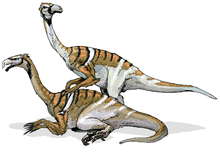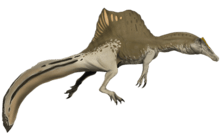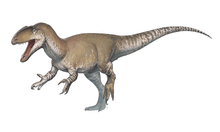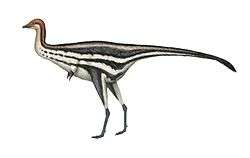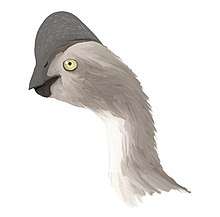Nanshiungosaurus
Nanshiungosaurus is a genus of therizinosaurian theropod dinosaur from the Cretaceous of China. The type species, Nanshiungosaurus brevispinus, was first discovered in 1974 and described in 1979, represented by a specimen preserving most of the cervical and dorsal vertebrae with the pelvis. A supposed, dubious second species, "Nanshiungosaurus" bohlini, was found in 1992 and described in 1997. It also preserves vertebrae but this species however, have a large age difference compared to the later and issues regarding authentic characteristics, making its affinity to the genus questionable.
| Nanshiungosaurus | |
|---|---|
 | |
| Skeletal restoration | |
| Scientific classification | |
| Kingdom: | Animalia |
| Phylum: | Chordata |
| Clade: | Dinosauria |
| Clade: | Saurischia |
| Clade: | Theropoda |
| Family: | †Therizinosauridae |
| Genus: | †Nanshiungosaurus Dong, 1979 |
| Species | |
Discovery and naming

The first remains of Nanshiungosaurus were collected in 1974 by an expedition team of the Institute of Vertebrate Paleontology and Paleoanthropology. Later on, in 1979 Nanshiungosaurus brevispinus was named and described by Dong Zhiming. The generic name refers to Nanxiong and the specific name is derived from Latin brevis, "short", and spina, "thorn", in reference to the short vertebral spines. The holotype specimen, IVPP V4731, was near Dapingcun in Guangdong found in a layer of the Nanxiong Formation, dating from the Late Cretaceous Campanian. It consists of a partial skeleton lacking the skull but including 12 cervical, 10 dorsal and 6 sacral vertebrae, and a bulky pelvis. It was first thought to be a small, strange sauropod characterised by a shorter but thicker neck than other sauropods.[1] The Nanxiong Formation has been dated to the Maastrichtian stage about 66.7 ± 0.3 million years ago.[2]
In 1997 Dong Zhiming and Yu Hailu named and described a second species: "Nanshiungosaurus" bohlini, based on a skeleton found in 1992 near Mazongshan. It consists of only 11 cervical and 5 dorsal vertebrae with some ribs. The holotype is IVPP V11116, from the Early Cretaceous Upper Xinminbao Group dating from the Barremian-Aptian. The specific name honours the Swedish paleontologist Birger Bohlin. Dong and Yu presented no evidence or argumentation supporting the assignment of the species to Nanshiungosaurus.[3] In view of the lack of synapomorphies, shared unique traits, and the large age difference with Nanshiungosaurus brevispinus, it is generally considered that the supposed second species is unrelated to the later and might warrant its own genus.[4][5][6]
Description

Nanshiungosaurus was a relatively large-bodied therizinosaur, estimated at 4.4 to 5 m (14 to 16 ft) long weighing 454 to 907 kg (1,001 to 2,000 lb).[7][5] "Nanshiungosaurus" bohlini is slightly larger, estimated by Paul at 6 m (20 ft) and 1.3 t (1,300 kg).[5] The number of sacral vertebrae was first determined at five,[1] later corrected to six.[4] N. brevispinus distinguishes itself by the possession of twelve, stocky cervical vertebrae with opisthocoel (meaning that they were concave on their posterior sides) centra.[4] Most cervicals have relatively short neural arches, but in the dorsals they are more elongated.[1]
The pelvis is represented by a well-preserved sacrum and left side composed by the illium, pubis and ischium; the pubis has lost its distal end though. The right side only preserves the ischium. As in most therizinosaurs, the pubis and ischium are fused into a solid structure. As a whole, the pelvis is robustly built. The sacral vertebrae are fused, indicating that the individual was an adult at the time of death.[1]
Classification
Nanshiungosaurus was in 1979 by Dong assigned to the Titanosaurinae, based on the assumption it were a sauropod.[1] In 1992 the species was assigned to the Segnosauridae, the group today called Therizinosauridae.[8] In 1997 however, Dong placed N. brevispinus and "N". bohlini in a separate Nanshungosauridae (now obsolete).[3] Cladistic analyses indicate a position for Nanshiungosaurus that is either basal in the Therizinosauridae[4][9] or just outside that clade, basal in the Therizinosauroidea.[10] Under the definition of Therizinosauridae sensu Xu 2002, Nanshuingosaurus is by definition a therizinosaurid.[11] The phylogenetic analysis conducted by Hartaman et al. 2019 recovers Nanshiungosaurus as a therizinosaurid in a more derived position than Erliansaurus or Neimongosaurus. Below are the obtained results:[6]
| Therizinosauridae |
| |||||||||||||||||||||||||||||||||||||||||||||||||||||||||||||||||||||
References
- Dong, Z. (1979). "Cretaceous dinosaur fossils in southern China" [Cretaceous dinosaurs of the Huanan (south China)]. In Institute of Vertebrate Paleontology and Paleoanthropology; Nanjing Institute of Paleontology (eds.). Mesozoic and Cenozoic Redbeds in Southern China (in Chinese). Beijing: Science Press. pp. 342–350. Translated paper
- Buck, B. J.; Hanson, A. D.; Hengst, R. A.; Shu-sheng, H. (2004). "Tertiary Dinosaurs in the Nanxiong Basin, Southern China, Are Reworked from the Cretaceous". The Journal of Geology. 112 (1): 111–118. doi:10.1086/379695.
- Dong, Z.; Yu, H. (1997). "A new segnosaur from Mazhongshan Area, Gansu Province, China". In Dong, Z. M. (ed.). Sino-Japanese Silk Road Dinosaur Expedition. Beijing: China Ocean Press,. pp. 90–95.CS1 maint: extra punctuation (link)
- Zanno, L. E. (2010). "A taxonomic and phylogenetic re-evaluation of Therizinosauria (Dinosauria: Maniraptora)". Journal of Systematic Palaeontology. 8 (4): 503–543. doi:10.1080/14772019.2010.488045.
- Paul, G. S. (2016). The Princeton Field Guide to Dinosaurs (2nd ed.). Princeton, New Jersey: Princeton University Press. pp. 162−168. ISBN 9780691167664.
- Hartman, S.; Mortimer, M.; Wahl, W. R.; Lomax, D. R.; Lippincott, J.; Lovelace, D. M. (2019). "A new paravian dinosaur from the Late Jurassic of North America supports a late acquisition of avian flight". PeerJ. 7: e7247. doi:10.7717/peerj.7247. PMC 6626525. PMID 31333906.
- Holtz, T. R.; Rey, L. V. (2007). Dinosaurs: The Most Complete, Up-to-Date Encyclopedia for Dinosaur Lovers of All Ages. Random House. ISBN 9780375824197.CS1 maint: date and year (link) Genus List for Holtz 2012 Weight Information
- Dong, Z. (1992). Dinosaurian Faunas of China. Beijing: China Ocean Press. p. 187. ISBN 3-540-52084-8.
- Zanno, L. E.; Gillete, D. D.; Albright, L. B.; Titus, A. L. (2009). "A new North American therizinosaurid and the role of herbivory in 'predatory' dinosaur evolution". Proceedings of the Royal Society B. 276 (1672): 3505–3511. doi:10.1098/rspb.2009.1029. PMC 2817200. PMID 19605396.
- Senter, P. (2007). "A new look at the phylogeny of coelurosauria (Dinosauria: Theropoda)". Journal of Systematic Palaeontology. 5 (4): 429–463. doi:10.1017/S1477201907002143.
- Xu, X.; Zhang, Z.-H.; Sereno, P. C.; Zhao, X.-J.; Kuang, X.-W.; Han, J.; Tan, L. (2002). "A new therizinosauroid (Dinosauria, Theropoda) from the Upper Cretaceous Iren Dabasu Formation of Nei Mongol" (PDF). Vertebrata PalAsiatica. 40: 228–240.
